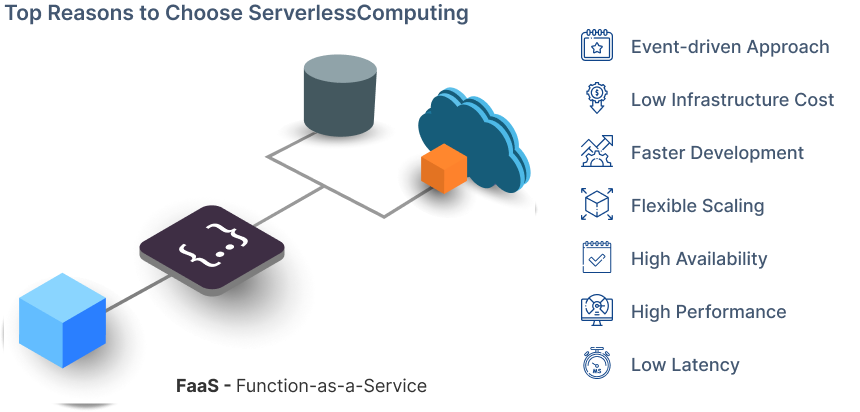Blogs / Cloud Native Development
Why Should You Choose Serverless Computing To Develop Cloud-Native Apps?
By
Harish K K
Posted: March 23, 2022
• 4 Min Read
Artificial Intelligence (AI) has become an increasingly popular topic in recent times, with ChatGPT serving as a prominent example of an AI-based module developed by OpenAI. However, little attention is given to the technology that enables its functionality, which is Serverless Technology.

But what exactly is serverless architecture, and how does it help organizations streamline their resource management? To fully leverage the benefits of serverless architecture, it's crucial to have a thorough understanding of what serverless computing entails, how it operates, and why it is an excellent choice for developing cloud-native applications.
What is serverless architecture?
Serverless architecture also known as Function-as-a-Service (FaaS) model is a cloud computing approach where the cloud provider manages and dynamically allocates the computing resources required to run an application, such as servers, storage, and networking. The term "serverless" does not mean that there are no servers involved, but rather that the organization does not have to worry about managing the servers.
What Is The Difference Between Traditional Architecture And Serverless Architecture?
In a traditional server-based architecture, the application runs on a server that is managed by the developer or the organization that is responsible for provisioning and maintaining the server, managing the operating system, and ensuring the server is always available and secure.
Conversely, in serverless architecture, the cloud provider manages the infrastructure required to run and scale applications including provisioning, scaling, and managing the servers. Serverless architecture is event-driven, meaning that the application code only runs when triggered by a specific event, such as a user request or a database update. Serverless architecture relieves developers from the burden of managing the infrastructure as the cloud provider assumes the responsibility of handling it, leaving them with the primary task of writing the code function.
How Does Serverless Architecture Work?
The core principle behind the serverless architecture is "Functions as a Service" (FaaS), which involves the cloud provider handling the infrastructure required to execute small code snippets, also known as "functions," in response to specific events. These functions can be written in any programming language and are typically short-lived, stateless, and triggered by events.
When an event occurs, such as a user making a request to an API endpoint, the cloud provider automatically allocates the necessary resources to run the function. The function runs in a container, which is automatically created and destroyed as needed. The cloud provider charges only for the time the function runs, which means that you only pay for what you use.
What Are The Benefits Of Using Serverless Computing
Serverless architecture offers several benefits that make it more convenient and functional compared to traditional server-based infrastructures. Partnering with a cloud computing services provider will help you make the most out of these benefits.
Let's have a look at the benefits of serverless computing.
- Reduced Infrastructure Costs
- Improved Scalability
- Faster Time-to-Market
- High Availability
- Low Latency
One of the significant advantages of serverless architecture is its pay-as-you-use model, which drastically reduces infrastructure costs for businesses. By leveraging serverless technology, you need to pay only for the computing resources used, which could save a significant amount of backend resources and maintenance costs. With serverless, businesses can allocate more resources towards developing new features and improving existing ones, rather than spending time and money on infrastructure maintenance. This helps to earn high ROI from your cloud investment.
The serverless model can handle large numbers of requests, making it an attractive option for businesses prioritizing traffic. Because of this reason, serverless architecture is particularly useful for applications with unpredictable traffic patterns. You don't have to worry about provisioning and managing servers or infrastructure to handle spikes in traffic as your cloud provider automatically handles scaling based on demands. Serverless makes this possible by executing functions within containers that start and stop as needed, providing a flexible and scalable infrastructure for businesses. This allows serverless applications to handle a large number of requests simultaneously, while still being able to process individual requests from single users.
With a serverless infrastructure, developers can easily release a functional application without the need to upload code to servers or perform backend configuration. This approach can significantly reduce the time-to-market for new applications. The application is composed of multiple functions provided by the vendor, and developers can upload these functions individually or all at once.
This approach enables fast updates, patches, fixes, and feature additions without requiring modifications to the entire application. Furthermore, with the ability to quickly add new features and technologies, every customer can access these changes almost instantly, providing a seamless and real-time experience for all users.
In a serverless architecture, the cloud provider takes responsibility for ensuring the high availability and fault tolerance of the applications running on their platform. This ensures that the applications remain operational and available, even in the event of server failures or other complications. To achieve high availability, cloud providers typically use a distributed architecture that replicates application code and data across multiple servers and data centers. If one server fails, the application can continue to run on other servers without interruption.
Serverless computing allows for greater flexibility in running application functions from various locations. By leveraging providers that offer serverless solutions, it becomes effortless to deploy app functions to servers that are closer to the end users. This distributed approach significantly reduces latency by minimizing the distance that requests must travel. As a result, the data transmission and processing time are significantly lower, leading to a faster and more responsive user experience. For example, the cloud provider can enable serverless functions to run in edge locations worldwide, allowing for speedy response times, improved performance, and user experience.
Final Thoughts
Even though adopting serverless architecture can offer so many benefits to both organizations and developers, it may not be the best fit for every application. However, implementing this model in a traditional IT system may present challenges and require a step-by-step approach. Seek guidance from cloud consulting experts if your business looks for serverless application development and cloud-native development services. This helps to ensure a smooth transition to a serverless approach without disrupting your business operations.


Get Know More About Our Services and Products
Reach to us if you have any queries on any of our products or Services.











